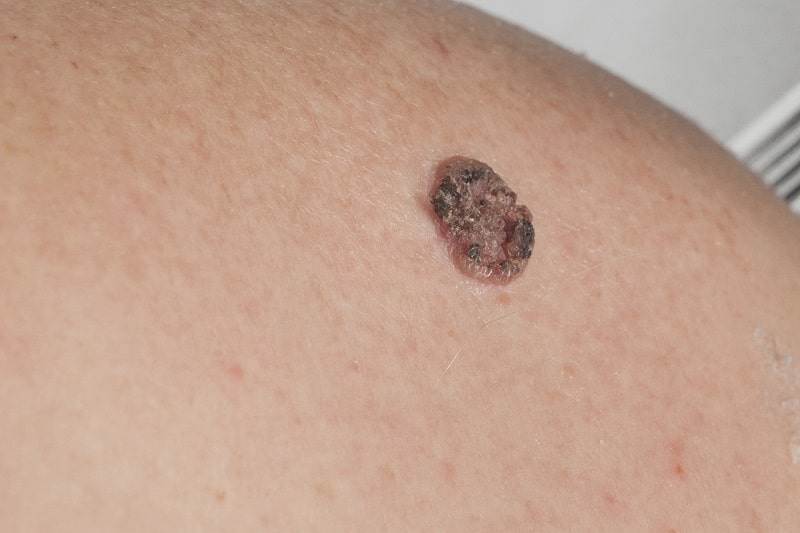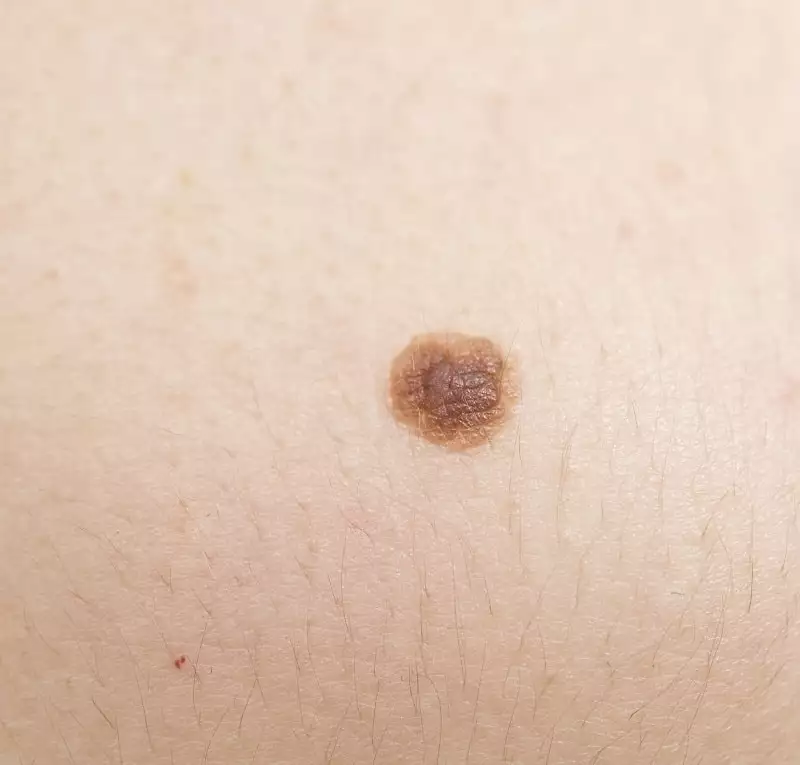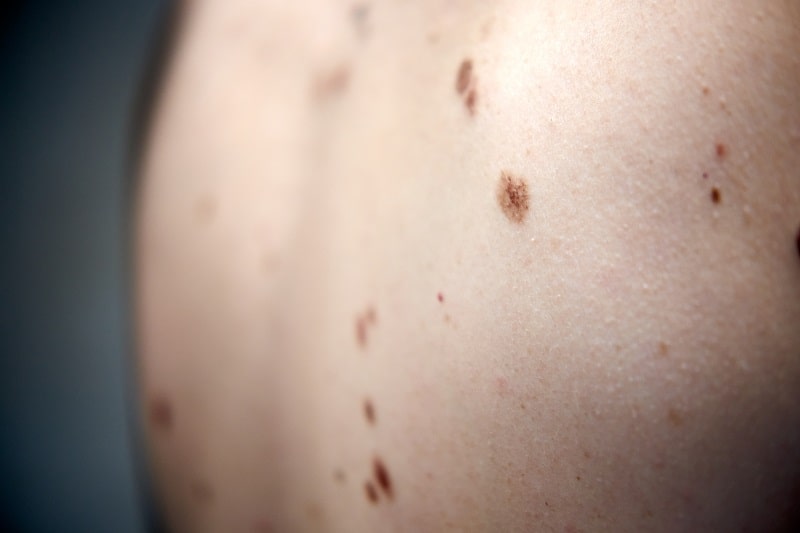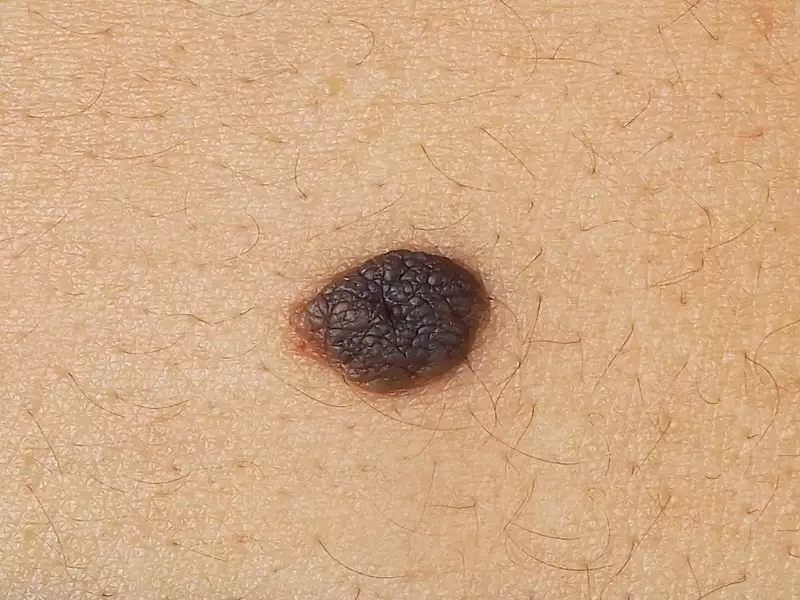
Melanoma

Treatment Duration
30
Suggested Sessions
2-4 times/year
Melanoma is currently recorded as the most aggressive skin cancer. Its frequency in the general population has been increasing in recent years internationally and in Greece. However, melanoma, can be treated with high success rates, when it detected early.
 «Melanoma accounts for 1% of skin cancers, but accounts for the majority of deaths they cause.»
«Melanoma accounts for 1% of skin cancers, but accounts for the majority of deaths they cause.»
What is Melanoma?
Melanoma is a dangerous, highly invasive cancer that spreads from the skin to many parts of the body. Melanoma originates from melanocytes, the cells found in the upper layer of the skin that produce melanin, the substance that gives our skin its color.
Usually, a dysplastic nevus pre-exists in the place where a melanoma is created, although a melanoma can also be created in a new place.
 «The number of melanocytes is the same in blacks and whites, what changes is the production of melanin by these cells.»
«The number of melanocytes is the same in blacks and whites, what changes is the production of melanin by these cells.»
Melanoma Causes
The exact cause of melanoma is not known. However, scientific research has concluded that UV exposure can cause melanoma to form or turn a mole into melanoma.
Moles - Melanoma : Photos





Melanoma & Risk Factors
All people regardless of color or ethnicity can develop melanoma. However, there are some who are more at risk.
The risk factors for developing melanoma are the following:
- Excessive sun exposure or unprotected exposure to solar radiation or indoor tanning.
- You have light skin and light eyes with naturally red or blonde hair. Less melanin in the skin equals less protection from the sun.
- You have had blister burns in the past.
- You have more than 50 moles. Most moles are harmless. However, your risk of developing melanoma increases if you have more than 50 moles, if you have a mole that covers a large area of skin, and if you have one or more atypical moles.
- You have a weakened immune system. For whatever reason your immune system is weakened, your risk of melanoma increases.
- Have you had another type of skin cancer or have been treated with melanoma in the past?
In this case, as in some other cancers, you are more at risk of melanoma.
Melanoma Types
Superficial Spreading Melanoma
Superficial melanoma appears as a flat, slightly raised lesion with irregular borders, in shades of brown, black, red-pink, blue, and white.
This is the most common type of melanoma, accounting for 60-70% of cases. It can appear on top of an existing mole or be a new lesion.
This melanoma is found anywhere on the body, with greater frequency on the trunk of men and legs of women, as well as on the back of both sexes.
As its name suggests, this melanoma grows predominantly and initially slowly in more superficial layers, before moving into its more invasive phase.
As its name suggests, this melanoma grows predominantly and initially slowly in more superficial layers, before moving into its more invasive phase.
Nodular Melanoma
Nodular melanoma is recognized as a lump on the skin, usually blue or black in color, and can often be pink to red in color.
Nodular melanoma is the second most common and the most "aggressive" type of melanoma. It grows and spreads faster than other skin cancers. The growth may be mushroom-shaped with or without a stalk. It usually appears on the face, chest or back, and can also be found in areas not exposed to the sun.
Lentigo Maligna Melanoma
Malignant lenticular melanoma usually looks like a large, slightly raised brown spot with an uneven border.
This is a less common form of melanoma, which affects older people, over 60 years old. It appears on skin that has been chronically damaged by the sun and mainly on the face and neck. It is the third most common type of melanoma, occurring more often in women.
Acral - Lentiginous Melanoma
Its appearance is characterized by dark lesions (eye spots or freckles).
This is a rarer form of melanoma in which the lesions are found in inconspicuous places on the legs and arms, on the palms and soles of the feet as well as under the nails.
This is a rarer form of melanoma in which the lesions are found in inconspicuous places on the legs and arms, on the palms and soles of the feet as well as under the nails.
Amelanotic Melanoma
Amelanotic melanoma is an achromatic or pink-colored hard mass, with a possible brownish light border, that may look like a scar or create a wound.
It is a rare type of melanoma, while the absence of color makes its clinical diagnosis difficult, resulting in it being noticed at an advanced stage.
Nail Melanoma
Melanoma of the nail is a rare form of melanoma and occurs mainly in people of Asian descent who are colored or have a dark skin tone.
Characteristic of the subungual localization of a melanoma is the vertical black line that can be created due to the deposition of melanin and should lead us to the dermatologist.
Melanoma in the Eye & Mucous
In addition to skin melanoma, there are also melanomas in other areas of the body, such as the eye (ocular melanoma), nose, mouth and genitals.
Metastatic Melanoma
When melanoma spreads and metastasizes, it is called metastatic melanoma. Common sites of metastases are the lymph nodes, bones, liver and brain.
Melanoma Symptoms & Self-Examination
Melanoma comes in different sizes and shapes. An early sign of melanoma is a spot that looks different on your body, such as a change in a mole or the appearance of a new one.
The following international guide with the first 5 letters of the alphabet can help you in self-examination of moles and in timely communication with your dermatologist.
Α - Asymmetry
The following international guide with the first 5 letters of the alphabet can help you in self-examination of moles and in timely communication with your dermatologist.
Β - Border
The contour of the mole is not clearly defined when it comes to melanoma.
C - Colour
Variation in color with locally dark and light to colorless areas is an indication that they should be evaluated by a specialist.
D - Diameter
Lesions larger than 6 mm should be checked by a specialist, because the possibility of some degree of dysplasia increases.
E - Evolution
A change in the size, color, or size of a mole is always cause for a visit to the dermatologist.
ABCDE is a valuable tool for the early diagnosis of melanoma. Many times, however, the characteristics of melanoma are not absolute.
That's why every change, every new mark on the skin. It should be examined by a dermatologist. For example, if all the moles you have on your skin are large brown or black and you recently saw a small red mole, you should get it checked out.
 «Any mole you have that changes in shape, size, color, or shows symptoms such as itching or bleeding should be examined by a specialist to rule out the possibility of melanoma.»
«Any mole you have that changes in shape, size, color, or shows symptoms such as itching or bleeding should be examined by a specialist to rule out the possibility of melanoma.»
Melanoma Diagnosis
Clinical examination and dermatoscopy by the dermatologist are important procedures in the office for the diagnosis of melanoma. Equally important is mole mapping especially in people with a medical history of cancer or with many moles on their body.
The biopsy, however, is the definitive test that will confirm any suspicion of melanoma. In the event that the result is positive, the next step is to investigate whether the melanoma has spread and stage it, for which the doctor will recommend additional tests.
 «Many suspicious pigmented lesions ultimately turn out to be benign.»
«Many suspicious pigmented lesions ultimately turn out to be benign.»
Melanoma Treatment
The stage at which the melanoma is located, its characteristics, as well as the state of the patient's general health will determine the treatment plan for treating the disease. Surgical removal is the treatment of choice for melanoma, while the doctor will also consider treatment options such as chemotherapy, immunotherapy, and radiation therapy.
Melanoma Prevention
The great defense we have against melanoma is prevention, that is, regular check-ups with the dermatologist, according to his recommendations and protection measures against ultraviolet radiation.
The basic prevention guidelines for melanoma are:
- We avoid exposure to the sun from 11 to 4 when the radiation is very strong.
- We use and do not forget to renew the sunscreen all year round even on cloudy days.
- We wear comfortable clothes and a hat that protects from the sun.
- We avoid the solarium.
- We familiarize ourselves with our skin, do self-examination and do not forget the regular visit to the dermatologist.

Frequent Questions
How does melanoma appear?
The majority of melanomas appear on normal skin and do not appear as moles. That's why it's important not to ignore every change you notice in your skin.
What symptoms other than those mentioned should lead me to the dermatologist?
Contact your dermatologist if you notice: Sores that won't heal, bleeding from a mole, black spots in the eyes, blurred vision, or vision loss.
Is melanoma curable?
There is no simple answer to this question. Melanoma is a serious disease that needs attention in its treatment and therefore after its diagnosis, quick and decisive manipulations are needed. After the biopsy and the staging that will result from the histological report and the other control, the treatment plan you will follow will be defined based on the stage of the disease.
How is malignant melanoma treated?
The treatment of melanoma in its initial stages can only be surgical. Other types of treatments such as immunotherapy and targeted therapy are effective for more advanced cases, often combined with surgery.
How can I protect myself from melanoma?
90% of skin cancers are caused by UV radiation, either by direct exposure to the sun or in solariums. You can effectively reduce the risk of developing melanoma if you do not burn your skin in the sun or other means, if you seek a shady place during the hours when the sun is most dangerous 12.00 - 4.00 p.m., if you use a sufficient amount of sunscreen (and apply it every 2 hours) and be even more careful near water, snow and sand for radiation reflections.
I noticed that one of my moles swelled up. What to do;
Any change in the size, color or shape of any of your moles is cause for a visit to your dermatologist to rule out malignancy.
Bibliography
- https://www.skincancer.org/skin-cancer-information/melanoma/
- https://www.eof.gr/c/document_library/get_file?p_l_id=14016&folderId=480449&name=DLFE-2440.pdf
- https://www.skincancer.org/blog/more-than-moles-melanoma/
- https://eody.gov.gr/maios-minas-eyaisthitopoiisis-gia-to-melanoma
- https://www.euromelanoma.eu/en-intl/
- https://www.cancercenter.com/cancer-types/melanoma/types
